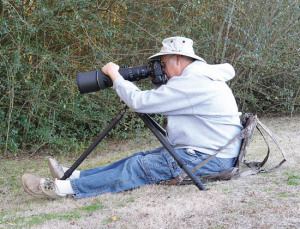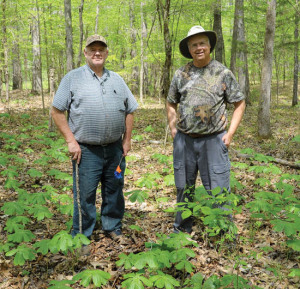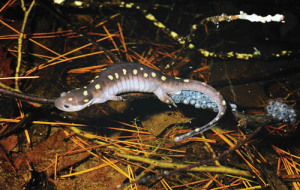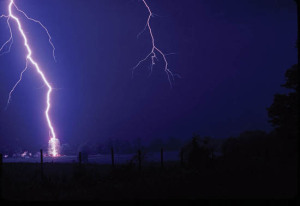Blend of nature, photography bring joy to Dixons Mills’ Autery
By Carolyn Drinkard
As a child, Johnny Autery would chase birds and butterflies on his family’s small farm in the rural community of Bradford’s Pond near Dixons Mills.
Autery was captivated by the outdoors and all the animals and insects living in this wonderful world. He would spend hours exploring creeks and ponds, looking for tadpoles, salamanders and frogs. He would lie on his back, look at the sunrises and sunsets, and wish he could capture the moment for eternity.

Other forces of nature fascinated him as well, things like fog, rain and lightning. In fact, there was very little in the great outdoors that did not capture the young boy’s attention. He was so awed by the beauty around him that he wished he could take a picture of everything that enthralled him. Autery would get his wish later in his life.
After graduating from Livingston University, he taught science and biology for 9 years. During this time, he was able to buy an Olympus 35mm camera, and he began to capture the natural beauty that had always intrigued him.
One natural phenomenon Autery had longed to photograph was streaks of lightning zigzagging and flashing across the sky. He kept a close eye on the weather, and, if he heard of an impending storm, he would rush to set up his equipment on a small hill near his home.
This was in the 1980s when a photographer had to shoot the image, send it to be processed, and then discover what he had captured. One time, after getting his slides back, Autery was amazed to find he had snapped a “once-in-a-lifetime” photograph of an incredible cloud-to-ground lightning strike.
He sent the slide to a professor at the University of Florida, who was doing research on lightning. The professor advised Autery to copyright the image, because it was truly something special. Since then, Autery’s picture has appeared in many publications such as Weatherwise magazine, National Geographic, and in numerous NOAA pamphlets and brochures.
It has also been used as a backdrop on the Weather Channel, shown on The Today Show, published in Weekly Reader, and used in many high school and college textbooks. In fact, he still gets requests for use of the photograph today.

The love of photography led Autery to leave teaching and take a job with a local portrait studio in Thomasville. After the studio closed, Autery delved in sports photography that he now features on his website. In the last 5 years, however, he has gotten even more serious about his passion to photograph the great outdoors, purchasing better equipment, and spending hours, looking, listening and learning.
Autery and his sister Ellen still live in their childhood home in rural Marengo County. Ellen plants flowers that attract birds, butterflies and bees. Her handiwork becomes a veritable sanctuary for Autery, who photographs the many visitors to Ellen’s garden.
He has developed many unique techniques to get close to the birds and insects, often putting feed around stumps to lure the birds closer to the blinds he has built. He also dons a camo cape to move in as closely as possible.
“It helps to know the habits of animals,” said Autery, who readily admits his background in biology has helped him immensely. “Animals don’t always cooperate. The behavior of animals and insects are a big part of what you must understand. I have to play with things to get the best shot.”
Usually, that means spending hours patiently watching, waiting and taking countless shots just to get one that meets his high standards.
From March until October each year, Ellen keeps hummingbird feeders in her yard. In August and September, as the migration waves come and go, the yard will be filled with hundreds of hummers, darting, spiking, and jostling for food and dominance. This provides an ideal opportunity for Autery to position his cameras on posts stationed strategically around the feeders. The images he captures are amazing!
As diverse as his interests are, Autery admits that frogs and salamanders intrigue him most. Near his home lies a small pond that dried up during a drought in the late ‘90s. When the rains returned, the pond created a haven for thousands of species. On many nights, Autery dons his waders, clears away the overgrowth, and spends hours photographing and recording the frogs.
“It’s a lot of waiting, hoping I can get into position to get a really good shot,” he stated. “The frogs are constantly calling and mating.”
He rarely worries about snakes, but says that he has seen a few while sloshing through the water.

Autery revealed that the most unusual thing he has ever photographed was a salamander laying eggs when it was snowing. The story behind this photograph is almost as intriguing as the image itself.
Lately, however, Autery has been researching the Red Hills Salamander, Alabama’s official state amphibian. The Red Hills Salamander is found only in five or six southern Alabama counties in an area between the Alabama River and the Conecuh River. Discovered in 1960 by a biologist studying snails, the Red Hills Salamander spends 95 percent of its life in its burrow, coming out only at night to feed on insects and worms near the entrance to its burrow.
Originally classified as an “endangered” species, it is now listed as “threatened.” This salamander has been identified in Wilcox County, and, now, Autery is on a mission to capture an image of the elusive creature.
Even though Autery now works as a freelance photographer, he has always dreamed of becoming a wildlife photographer. His good friend Big Daddy (James) Lawler, host of the Gettin’ Outdoors Radio Show, believes Autery is already the true definition of what an outdoor photographer should be.
“I have had the absolute pleasure of sharing time with and observing Johnny in the field,” Lawler said. “His professionalism in his craft is not only seen in the images he captures but also in the respect and knowledge of his subjects. Whether it is a fast-snapped shot of a high school-split end diving for a touchdown pass or waiting for that shot of a croaking frog in a Marengo County mud hole, Johnny has the same dedication and commitment to capturing each image.”
People in Marengo, Clarke and Wilcox counties know Autery is much more than just a country photographer. Many see him as a resident conservationist, naturalist, ecologist, environmentalist and preservationist. Autery admits that, even though he’s not into labels, he’s probably a little bit of each because he loves being outdoors with all the unusual creatures that interest him.
“I’ve learned how fragile and intricate nature is,” he said. “So many species are declining because of man’s intrusion, and I want to help stop this. I want to help study and preserve all species.”

For Autery, the flora and fauna found in the hills and hollows around his country home are both his canvas and his chronicle.
“I photograph the animals and flowers around me, so everyone can learn to appreciate and love what we have,” Autery stated. “Whether it’s waiting for the next lightning strike, wading in a woodland pool at night looking for that perfect frog pose, spending countless hours watching and imaging birds or on the sidelines trying to anticipate that next great Bulldog (Sweet Water) play, photography is my passion.”
Autery may be a man of few words, but his photographs speak volumes, in a language everyone can understand and appreciate.
Contact Johnny Autery at johnnyautery@zenfolio.com or 2auterys@pinebelt.net. He can also be found on Facebook.
Carolyn Drinkard is a freelance writer from Thomasville. Her article is reprinted with permission from Alabama Farmer’s Co-op’s Cooperative Farming News. Autery regularly submits photographs to The West Alabama Watchman.

